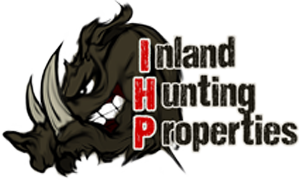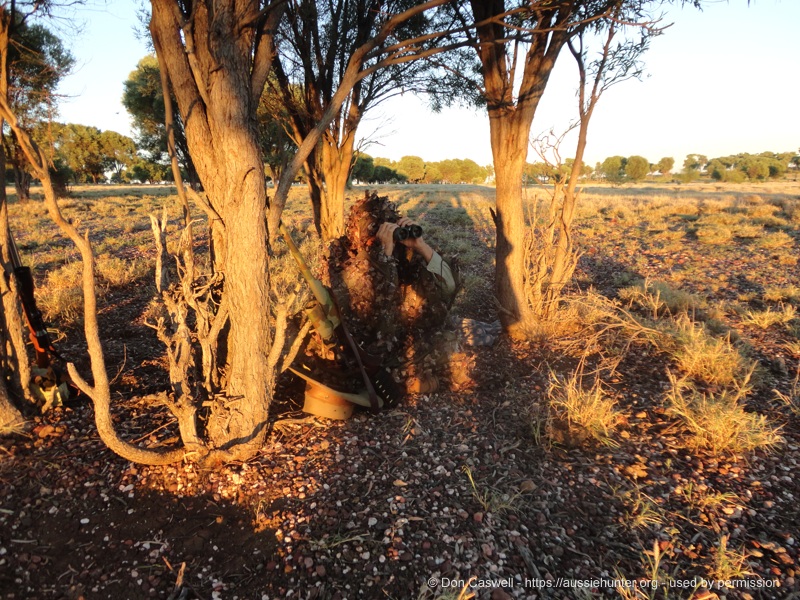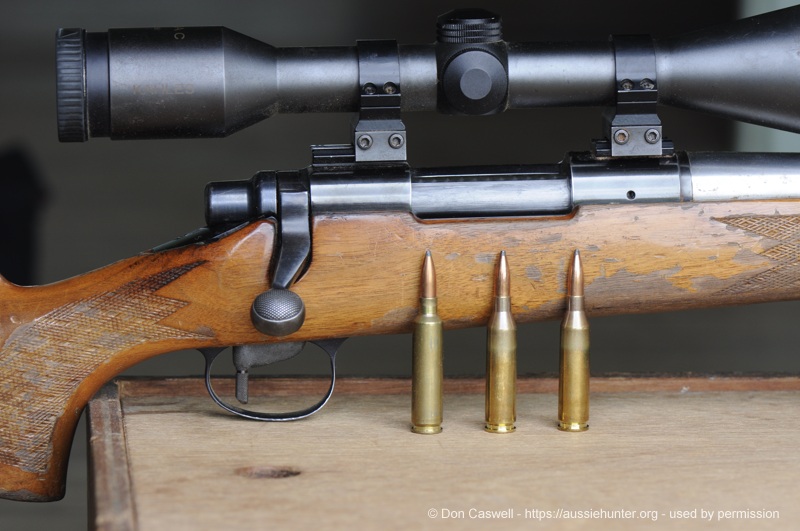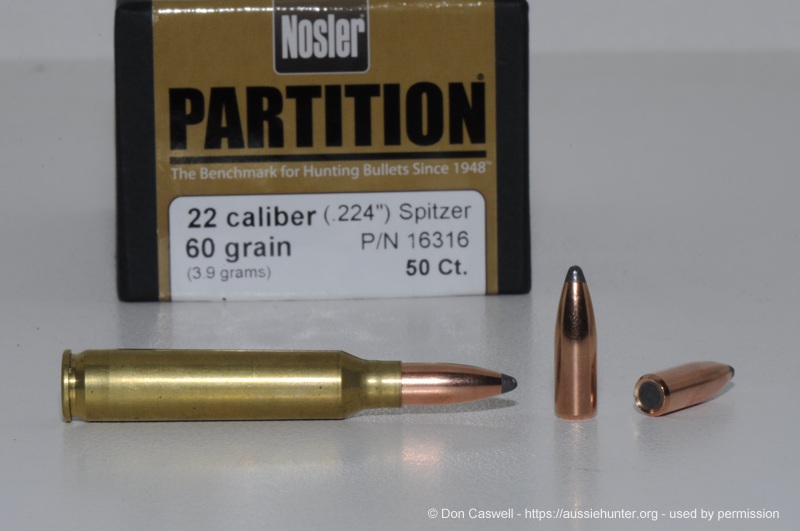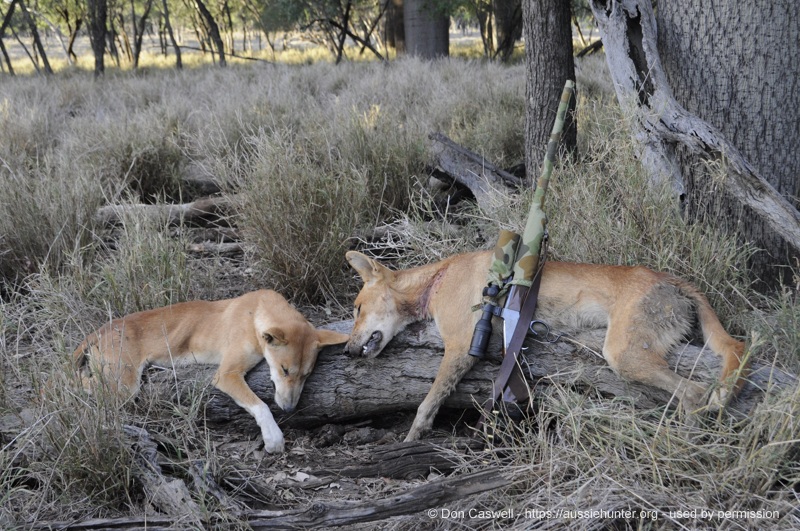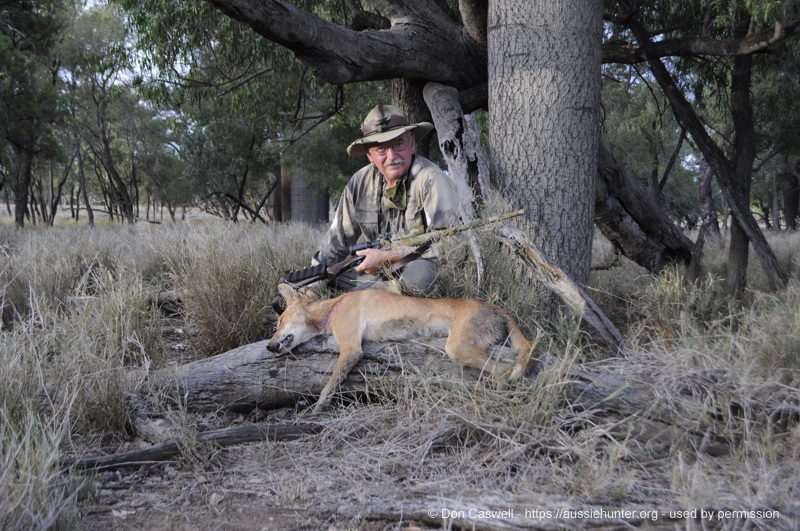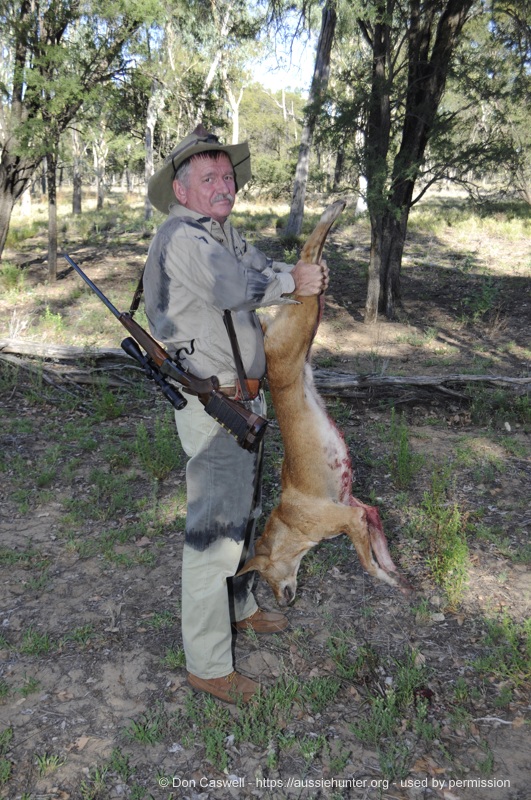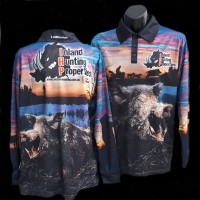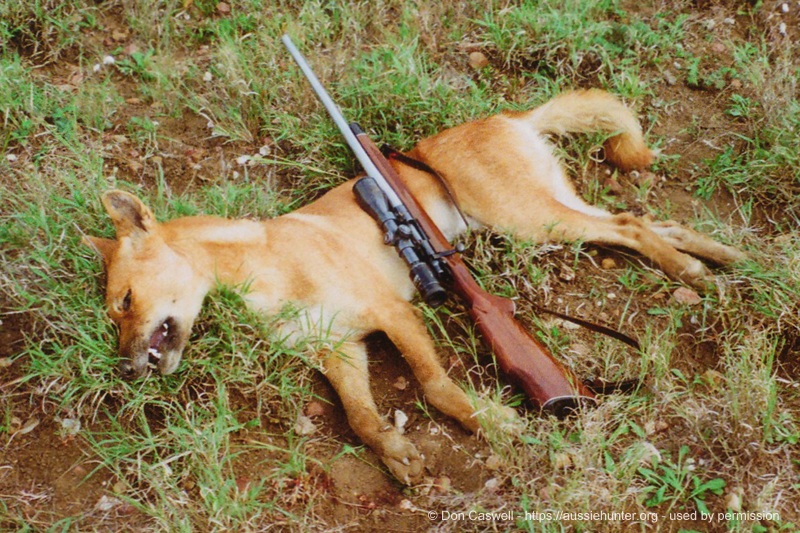
Hunting the educated wild dogs of the western grazing lands is a real challenge. Don Caswell gets some coaching from a professional dogger.
Story and photos by Don Caswell - Aussie Hunter Website
It had been another 3:30AM start. After a twenty-five kilometre drive over dirt tracks we had then walked a kilometre or so in the dark. A small, dim, torch pointed at our feet helped us avoid tripping over dead timber in the grass, or worse, stepping on a Mulga snake. We settled into a grove of gidgee on the edge of an extensive grassed area and waited for first light. It was not called the eight thousand acre paddock for nothing.
At the moment it held a small mob of fat steers. Soon, they would be mustered and after that the new tenants would arrive; a herd of pregnant cows. There were also wild dogs in the paddock too, a bitch with two full grown pups from last year’s breeding season. While they would mischievously buzz the steers, just for the hell of it, and which we had witnessed firsthand, they did not pose any threat to those large animals. However a batch of new born calves would be at great risk and the grazier had lost many calves to dogs in this paddock over the years.
From our concealed vantage point we glassed the surrounding terrain. We could track the dogs without actually seeing them by watching the kangaroos. There were roos spread all over the paddock, grazing unconcernedly as first light came. Suddenly Robbie spoke quietly.
“See that mob of roos up near the split boab tree? About 800 metres away. They have all just gone on guard, they have just heard, or more likely smelt, the dogs. See how they are behaving and scanning about. Keep watching because the action is just starting. Look for any roos on alert, or on the move.”
Within a few moments I noticed another bunch of roos sit upright and all look in the same direction. I drew Robbie’s attention to that. “Yep, they have spotted them alright. The fireworks are about to go off! Look for any roos scattering, the faster they move, the closer the dogs will be on their heels.”
As if on cue, another small mob roos a little further on suddenly launched into high gear. Even though it was about a kilometre away, and still pre sunrise, I could see the action in great clarity through my Swarovski 10x42 binoculars. I caught a few fleeting glimpses of two wild dogs bounding through the long grass behind the roos. “Robbie, up there, I see two dogs.”
The dogs hunt the edge of the open grassland, where the roos were grazing. Even though we could not see the dogs after the initial sighting we could tell exactly where they were from what was, for all intents and purposes, a “Mexican Wave” of kangaroos cascading along the tree line for a couple of kilometres. “Ah!” said Robbie dryly, “the Roo-ometer is working well today.”
It was all over in a minute or two. The dogs were obviously travelling fast. It seemed that they ran at the grazing roos, putting them to flight. Once the dogs had swept past the roos pulled up, but remained wary for some time.
“They will buzz up a couple of hundred roos. If one slips, hesitates or makes an awkward change of direction, they will be onto it and pull it down. Most times they will just kill and then resume the hunt. They kill a lot more than they ever eat,” observed Robbie. We had seen their handiwork along the bordering netting fence where there were dozens of roos killed by the dogs. “They do the same with sheep and goats too, “ Robbie went on, “The neighbour had thirty sheep killed in one night a couple of weeks back, and wait till we visit the hill. They have killed hundreds of goats there. It’s a real bone yard.”
“Anyway, we know their routine now. They hunt right through to that patch of thicker timber on the edge of the open grass,” he pointed, “then they take a drink at the cattle trough over further before heading home to their base in that clump of timber.”
In our forays we had carefully avoided that clump of timber, giving it a good 500 metre margin. Our chances of successfully stalking the dogs while they were resting at home, so to speak, were pretty low. They would be on full alert and very wary. On top of that, our intrusion into their rest area would quite likely prompt them to move to another base camp, and change their hunting patterns as a result. We would have to locate them all over again.
“Tomorrow, if they are true to form, we will be waiting for them, that’s our game plan,” stated Robbie, who has made an art form out of understanding dog behaviour, then bushwhacking them. Robbie, on average, shoots four or five wild dogs per week using this methodology. In a good week he may shoot a dozen, in a bad week maybe only one or two. Least productive is the week or so around the full moon, especially if windy and clear skied. On bright moonlit nights the dogs will often hunt at night and be camped up by dawn. On dark nights they generally hunt with the sunrise.
We waited another couple of hours, just in case the dogs went for another run, but we saw no more sign of them. As we made our way back to the homestead for a late breakfast we discussed rifles and calibres.
After a lot of thought, Robbie had opted for a custom built Remington 700 in 243 Ackley Improved as his walk around dog gun. He uses 85 grain Sierra projectiles for that and it is a very accurate and hard hitting load. The rifle is topped off with a Kahles 8x56 which has razor sharp optics and great light gathering capability; something quite important when stalking wild dogs in the twilight. He already had a custom varmint rig, based on a Rem 700, in 6mm BR when shooting from the vehicle and it made sense to stick with the 6mm theme.
Robbie told me that the dogs he typically encountered were big robust specimens, heavily muscled with deep chests. “Wait till we get our first big male and skin him, then you will see what I mean,” Robbie assured me. Some of the shots would, by necessity, be long ones so hard hitting, flat shooting calibres were the obvious choice for this line of work. While he accepted that I found my 223 Remington to be a good dog gun in my neck of the woods, he felt it would not measure up on his big, open country dogs. When I told him I was loading 60 grain Nosler Partitions he felt a bit more comfortable with my choice of rifle and load.
The next morning we were back in the eight thousand acre paddock. This time we made a bee-line for the ambush point. We sat back in the shadows of the tree line as first light came, then a little while later the sun rose in our faces, accompanied by a light easterly breeze. We were scanning the grasslands keeping a close watch on the roos. Then, a little after sunrise, we could see the roos over a kilometre away starting to scatter, like we saw on the previous days.
“Quick, move forward, and stay in the shadow of the tree trunks, the dogs will be here in a no time,” Robbie commanded. We moved forward to the very edge of the great expanse of pasture, taking up position behind the last few saplings there. “When they get close I’ll get their attention and slow them down. You’ll have to shoot fast though, you shoot to your right, I’ll shoot straight ahead and to the left, okay?” he confirmed.
It seemed like only a few moments later we had a dozen roos go flying past us, and hot on their heels was a large, bounding dog. The dog was racing after the roos and would have passed within 50 metres of our position. When it was about 70 metres off, Robbie gave a shrill blast on the rabbit whistle in his mouth. The dog was loping along left of my position so the shot was Robbie’s. At the whistle, the dog’s attention swung our way and he wheeled in towards us. The 243 Ackley Improved barked and the dog was pole-axed in mid stride.
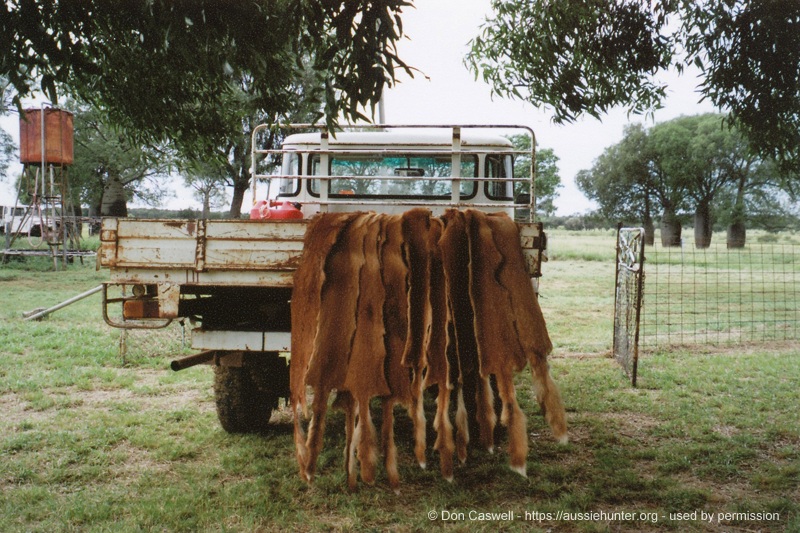
We remained motionless for some time, intently scanning the savannah and scattered trees for any sign of the other dogs. After maybe twenty minutes, Robbie gave a low, soft dog howl; the “where are you?” call. There were answers from both the left and right. Time drifted on and the occasional call from either side told us the dogs were seeking to flank us and get the wind before coming any closer.
After a hushed discussion, centred on a strict safety protocol about what shots we could take, we split up and sought to stalk the other dogs. An hour slipped by in no time then, as agreed we made our way to a pre-arranged rendezvous point. After some discussion about what we had both done and seen, we returned to check out the dead dog. “Well, there’s a surprise,” said Robbie, picking up a hefty, male dog, “where did this fellow come from? We have not seen hide nor hair of him until now. He is an old fellow too, look at the scars and greying muzzle.” After a few photos Robbie deftly scalped the dog, which represented a pay cheque for his ongoing efforts to control wild dogs.
That afternoon, we went to check a dam not far from the homestead. We were simply looking to shoot a few pigs. Quite unexpectedly we found a host of dog tracks, partly obliterated by cattle tracks. That changed the game plan. After a thorough search around the dam it looked as though the dogs had come to the water the previous afternoon. There was every reason to suspect that they would do that again, so we took up a position amongst a grove of trees next to a cattle pad that led to the dam.
We sat quietly for a couple of hours, watching the cattle and roos that came to drink. We chatted softly, confident that the animals at the dam would warn us of the dog’s arrival. Without warning a dog appeared on the wall of the dam and, after a brief pause, came toward us at trot. That was the exact opposite of what we had expected, but we quickly adapted. Luckily the dog did not notice me as I swivelled around to bring a rifle to bear on him. He filled the scope and I could see the water still dripping off him and the wet mud on his legs and belly. It was an easy shot and the 60 grain Nosler Partition delivered an emphatic kill.
Once more we sat quietly, keeping an intense lookout for any more dogs. Another hour passed quickly and the sun was getting ready to set. I whispered to Robbie that I would go and collect the dog and try to get a few photos before we lost the light. Maintaining a good lookout and moving slowly I covered the fifty metres and had just started photographing my quarry when I heard Robbie give a low dog moan.
That could only mean he had spotted, or heard another dog. I began to sink down into the grass beside a hefty tree trunk, prepared to maintain a low profile until the situation resolved itself, one way or another. That proved not to be necessary and the bark of Robbie’s 243 Ackley Improved reverberated through the trees, followed almost instantly by the resounding smack of a solid hit. A minute or two later Robbie came toward me carrying a fine looking young adult female. A pair of young dogs looking to establish a territory of their own, we had chanced onto them and got a good result.
Tomorrow we would move on to a couple of the rocky low hills where the really hard case, older dogs invariably took up residence. They would be much more challenging to come to terms with, but that is another story.
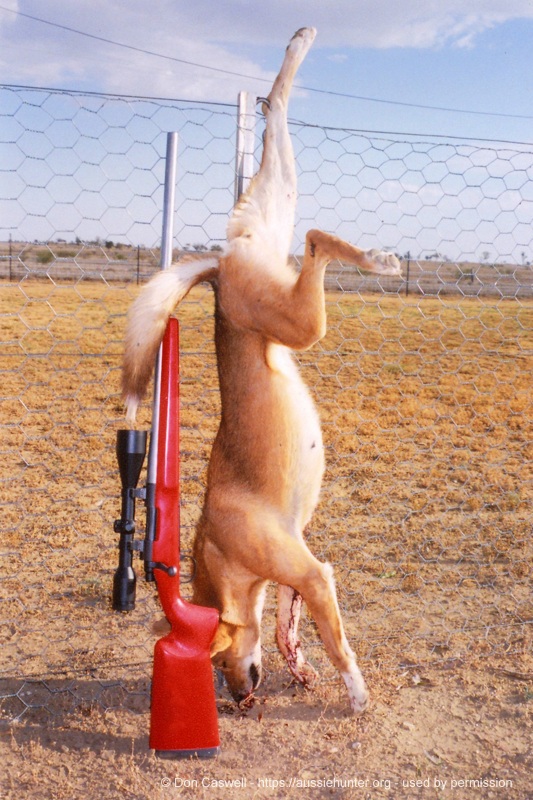
© Don Caswell 2014
About the author
Since 1981 Don Caswell has been a freelance writer, photographer & illustrator. Don is the author of hunting stories and the provider of technical shooting information. Don an independent reviewer of hunting, shooting & outdoors products, in addition to being a blogger & webmaster with Facebook & Instagram presence. Don is also a senior writer for the Sporting Shooters Association of Australia (SSAA) and his articles appear regularly in their publications. This article was originally published in the SSAA in April 2014.
Visit Don Caswell's Aussie Hunter Website here
